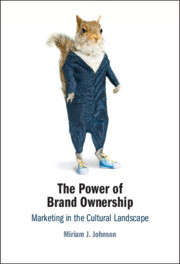Book contents
- The Power of Brand Ownership
- Reviews
- The Power of Brand Ownership
- Copyright page
- Dedication
- Contents
- Introduction
- 1 What We Mean When We Talk about the Cultural Landscape
- 2 Using Brands as Landmarks for Mapping the Cultural Landscape
- 3 Brand Capital, Perspective, and Power
- 4 The Role of Gender
- Case Study 1 Gender
- 5 The Importance of Authenticity
- 6 Brand Activism as a Power Dynamic
- Case Study 2 Activism
- 7 Ownership as Power
- 8 The Transience of Power in the Cultural Landscape
- Case Study 3 Shifting Power
- 9 TL;DR
- Works Cited
- Index
Introduction
Published online by Cambridge University Press: 14 January 2025
- The Power of Brand Ownership
- Reviews
- The Power of Brand Ownership
- Copyright page
- Dedication
- Contents
- Introduction
- 1 What We Mean When We Talk about the Cultural Landscape
- 2 Using Brands as Landmarks for Mapping the Cultural Landscape
- 3 Brand Capital, Perspective, and Power
- 4 The Role of Gender
- Case Study 1 Gender
- 5 The Importance of Authenticity
- 6 Brand Activism as a Power Dynamic
- Case Study 2 Activism
- 7 Ownership as Power
- 8 The Transience of Power in the Cultural Landscape
- Case Study 3 Shifting Power
- 9 TL;DR
- Works Cited
- Index
Summary
The concept of the cultural landscape represents a liminal space where physical and digital geographies intersect, creating a dynamic terrain where consumers, brands, and the landscape itself interact to create meaning and establish value. This introduction highlights the intricate relationship between brands and consumers within this landscape, exploring the fluid exchange of power and identity construction that occurs in these interactions. With a focus on how brands and consumers co-create meaning and value, the book examines the formation and exchange of capital, gender, authenticity, activism, and the power dynamics that come into play between consumers and brands.
Information
- Type
- Chapter
- Information
- The Power of Brand OwnershipMarketing in the Cultural Landscape, pp. 1 - 5Publisher: Cambridge University PressPrint publication year: 2025
